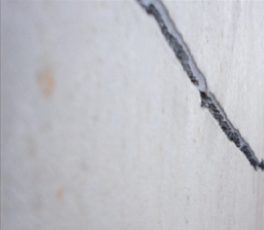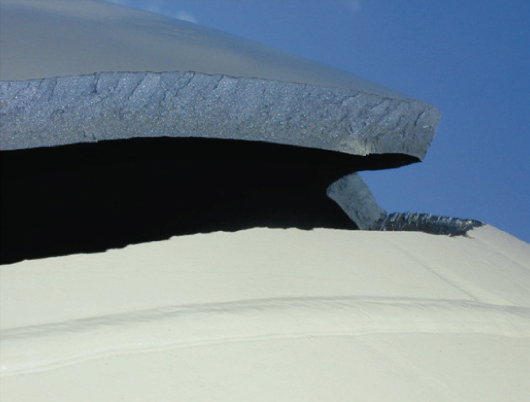In previous parts of this series, I have covered many corrosion and degradation issues, some environmental cracking diseases, metallurgical degradation mechanisms, issues associated with welding and some external corrosion problems. In part 14, I’m going to cover some one of the most insidious “diseases” associated with process equipment that can and does cause catastrophic pressure equipment failures: brittle fracture.
Brittle Fracture
Brittle fracture is the sudden, very rapid fracture under stress (residual and/or applied) where the material exhibits little or no evidence of ductility or plastic degradation. What does that mean? Unlike most tensile failures, where the material plastically strains under overload conditions and becomes thinner at point of rupture, when a piece of equipment suffers a brittle fracture, there is no thinning or necking down. Rather it breaks “like glass” without warning, and may in fact fracture into many pieces “like glass”. Those who have actually heard or seen a brittle fracture can attest to how “scary”, how sudden and how loud it is.
The most susceptible materials are carbon and low alloy steels, but also including the 400 series martensitic steels, like the 12 Cr varieties. There are a number of key factors that combine to give rise to susceptibility to brittle fracture. One of the most important factors is temperature. If the steel temperature is below its brittle-to-ductile transition temperature, then it will be susceptible to brittle fracture. Combine this “low temperature situation” with a critical sized flaw and high stress on that flaw (either applied or residual), then you are likely to experience a brittle fracture. Like the “fire triangle” that most of us have heard about, we also have a brittle fracture triangle. The three sides of the brittle fracture triangle are 1) low toughness (caused my material properties or low temperature); 2) critical sized flaw in the material (like a weld defect or other stress concentration); and 3) high stress on that flaw (like those one might experience at the edge of a nozzle or attachment weld, i.e. tri-axial stress state)
Other factors that can and do increase the susceptibility to brittle fracture include: a) metallurgical degradation, like can occur in some steels at higher temperatures e.g. temper embrittlement, graphitization, sigma phase embrittlement and 885 embrittlement; b) steel cleanliness and grain structure, e.g. large grain sizes and steel contaminants typically reduce steel toughness, which is a measure of resistance to brittle fracture; and c) material thickness i.e. the thicker the component the higher the likelihood of susceptibility to brittle fracture due to higher tri-axial stresses. Thicker materials produce a state of higher constraint, and therefore less likely to deform under stress as opposed to crack initiation and propagation.
An in-service brittle fracture is one of those very low probability – very high consequence events that must be avoided “at all costs”. Hence inspectors, engineers and operators must be knowledgeable in the potential for brittle fracture of materials operating below their brittle-to- ductile transition temperature (that’s “metallurgical speak” for operating below a temperature range where they are resistant to brittle fracture). API RP 920, Prevention of Brittle Fracture of Pressure Vessels (which unfortunately is now out of print), outlines some effective inspection and maintenance steps to take to avoid this potential. Special care and detailed procedures are necessary to control cooling and heating rates of heavy wall equipment in hydroprocess environments. API RP 579 (Section 3), Fitness for Service also provides excellent guidance on how to assess the potential for brittle fracture of equipment. API 510 Code for Inspection of Pressure Vessels In-Service also contains good guidance on avoiding brittle fractures of pressure vessels.
Every few years I read about a catastrophic loss/ accident as the result of a brittle fracture. One of the last fatal ones that I’m aware of was in a gas plant in Victoria Australia, which resulted in two fatalities, and a very large loss for the company, as well as a huge impact on customers that went without heating fuel during some cold climatic conditions. Prior to that incident, a nozzle fractured and fell off an operating column in an ethylene plant at a mid-west petrochemical plant, resulting in a catastrophic incident and enormous fire.
One of the most important Integrity Operating Windows (IOW’s) that needs to be established for each piece of susceptible equipment is that which specifies the Minimum Design Metal Temperature (MDMT) below which equipment should not be operated because of increased susceptibility to brittle fracture. In the case of the incident in Australia, all but one operator said they had no knowledge of the potential for brittle fracture or MDMT when their chiller suddenly iced-up on the outside just before it failed catastrophically.
Fortunately, many of the brittle fractures that I hear or read about occur when vessels are out of service, and quite often are the result of hydrotesting operations. Not too long ago, a major gulf coast refinery experienced a major crack in a FCCU refractory lined vessel. The vessel had been repaired on-the-run by installing a refractory lined box over a hot spot that had developed from refractory deterioration on the ID of the vessel. During the ensuing T/A, during vessel repairs, a loud crack startled the workers while they were working on the inside of the vessel. The crack shown in figure 1 and 2 emanated from the box and ran nearly 180 degrees circumferentially around this large pressure vessel.
Another classic example of a brittle fracture that made the rounds on the Internet a couple of years ago involved a brittle fracture during hydrotesting. See figures 3&4 below.
This one added to the numerous other ones that I am aware of during hydrotesting, which seems, based on history, like one of the most likely time to experience brittle fracture for a number of reasons, including: 1) too often not enough attention is paid to the need for heating the water (thereby heating the metal) in order to make sure that the test is conducted above the brittle-to-ductile transition temperature; 2) too often hydrotests are conducted during low ambient temperature conditions, thus compounding the temperature control issues; 3) not uncommonly insufficient attention is paid to flaw detection before conducting hydrotests on equipment susceptible to brittle fracture, and 4) too often the people involved in making decisions about if and how to conduct the hydrotest are not knowledgeable about the risk of brittle fracture. I remember one brittle fracture during hydrotesting that emanated from a new manway repad that had an almost undetectably small flaw at the edge of the weld. Most of the stress concentration that gave rise to the fracture came simply from the sharp geometric stress concentration where the weld met the base metal without sufficient stream-lining and contour i.e. weld grinding to smooth the transition.
Even more risky, for equipment susceptible to brittle fracture, than hydrotesting may be is pneumatic testing. The risks of brittle fracture are much higher with pneumatic testing because the consequences of a brittle fracture are so much higher. The consequences of a brittle fracture from a properly conducted hydrotest, (i.e. has no air remaining in the vessel during pressurization), are fairly low (only during hydrotest), and usually involve only the loss of the vessel. On the other hand the consequences of a brittle fracture during a pneumatic test (or hydro-pneumatic test) usually are the result of huge fragments of the vessel that are propelled with very high energy for hundreds of feet, sort of like the world’s largest grenade. No pneumatic pressure tests should ever be conducted without someone involved who is very knowledgeable in the potential for brittle fracture. That is even more true on heavy wall equipment.
Another petrochemical type operation that can and has caused brittle fractures involves nitrogen cooling or injection of gaseous nitrogen for other reasons into pressure equipment. If the process involves liquid nitrogen that is being gasified, then it’s vitally important that the equipment be designed and operated in a “fail-safe” manner that prevents any of the liquid nitrogen from bypassing the gasifier (heater/vaporizer) and entering equipment that is not designed for the extremely low temperatures of vaporizing nitrogen liquid. Several spectacular brittle fractures have resulted from such scenarios.
It’s often said, “You cannot inspect for brittle fracture”. But that’s not entirely true. Though we can’t inspect or brittle fracture like we inspect for corrosion, we can inspect for potential critical flaws that are established by a fitness-for- service (FFS) analysis in accordance with section 3 of API 579. It sometimes takes only a very small flaw to give rise to a brittle fracture, especially in heavy wall equipment. It’s important that inspectors ask engineers if equipment might be susceptible to brittle fracture during normal operation, during potential mis-operation, or during start-up or shut- down conditions. If that were to be the case, then a FFS analysis should be conducted in order that inspectors know where to look and what size flaw to look for, which would then need to be eliminated to avoid the potential for brittle fracture. If equipment is expected to lose toughness by some sort of metallurgical degradation during service, e.g. temper embrittlement, then the critical flaw size may be decreasing with age. If that were the case, or if crack-like flaws might be growing during service, then an inspection program for susceptible equipment should be devised to locate, size and repair such critical flaws that may be present, e.g. in hydroprocess equipment.
Conclusion
In part 14 of this series I have covered one more of the 99 “diseases” that can cause failure of pressure equipment; but there are plenty more corrosion and degradation issues. Next time, I will cover a few more types of equipment degradation associated with welding defects/flaws. In the meantime, is the potential for brittle fracture prominent at your site during discussions involving: 1) risk-based inspection plans, 2) management of change issues, 3) process hazards analysis, and 4) all pressure tests? Do you have established integrity operating windows (IOW’s) for minimum design metal temperatures (MDMT) for all equipment that may be susceptible to a brittle fracture in- service, especially from inadvertent misoperation? When you conduct repairs on a pressure vessel with an MDMT, do you take steps to establish (with FFS) and find (with NDE) any flaws that might initiate a brittle fracture in-service or during pressure testing? Do all of your operators have the basic knowledge and understanding of MDMT that they need in order to help avoid brittle fractures of pressure equipment in your facilities? Remember, it does little good for this important information to only reside in a select few engineers or technical specialists in your company.
If you have comments or feedback on the 99 Diseases of Pressure Equipment, please forward them to me though the IJ at inquiries@inspectioneering.com. I’ve now covered approximately 75% of the 99 Diseases. What other ones would you like me to address?




















Comments and Discussion
There are no comments yet.
Add a Comment
Please log in or register to participate in comments and discussions.